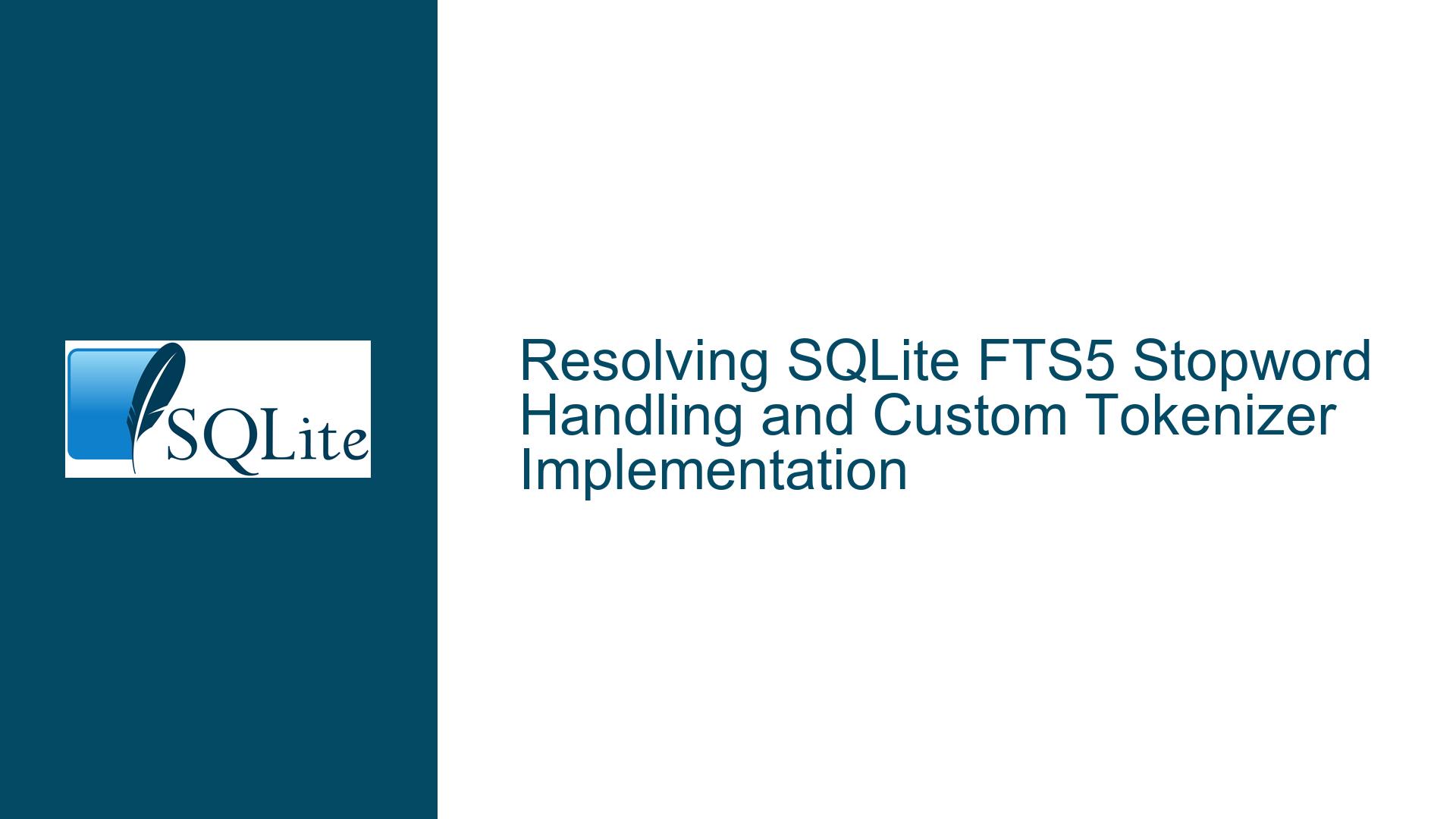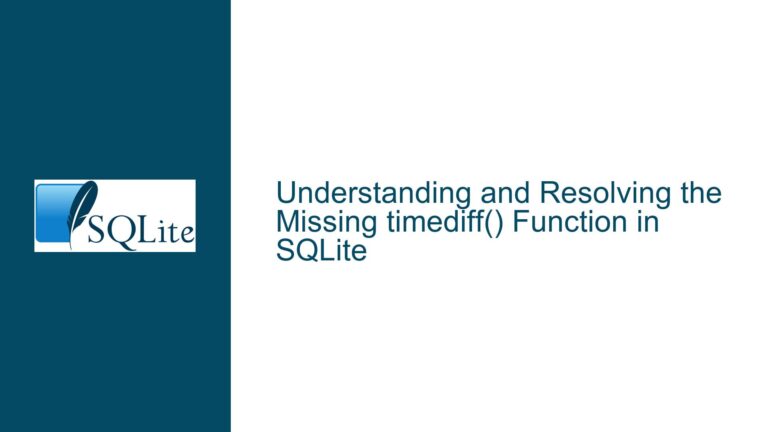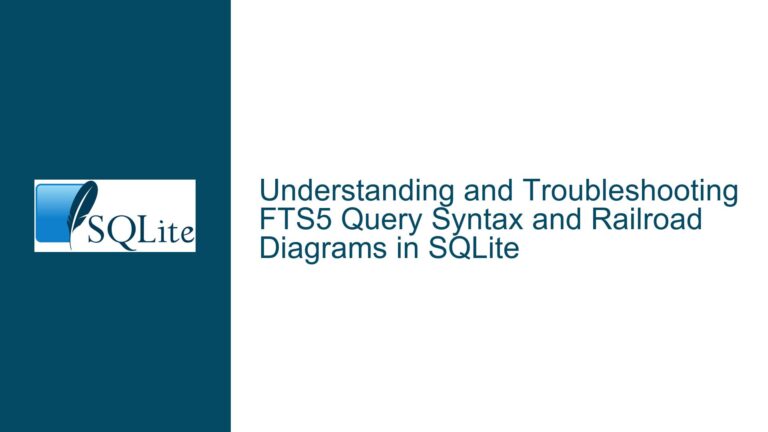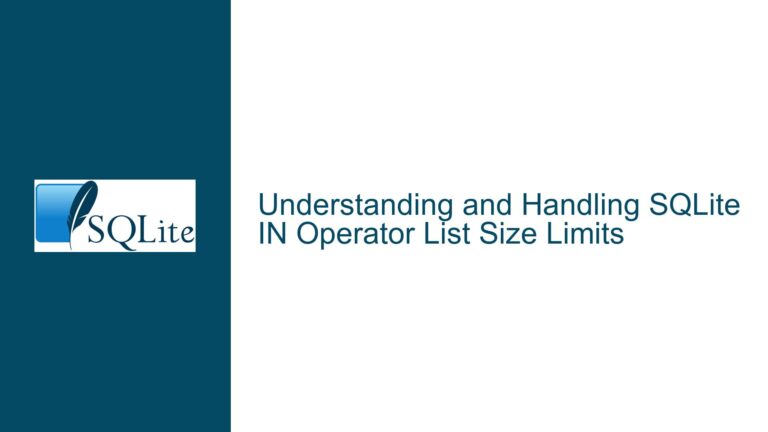Resolving SQLite FTS5 Stopword Handling and Custom Tokenizer Implementation
SQLite FTS5 Stopword Absence and Tokenizer Configuration Challenges
Issue Overview: Absence of Built-In Stopword Support in SQLite FTS5
SQLite’s Full-Text Search (FTS) extensions, particularly FTS5, do not include native support for stopwords—common words like "the," "and," or "in" that are typically excluded from search indexes. This omission contrasts with many other database systems where stopword lists are preconfigured or easily adjustable. The absence of built-in stopword management forces developers to implement custom solutions to prevent these terms from consuming storage and degrading query performance.
Stopwords are excluded in full-text search systems because they add negligible value to search relevance while increasing index size. For example, in a corpus of English documents, terms like "a" or "the" appear frequently but rarely contribute to meaningful search results. SQLite’s FTS5 module delegates tokenization (splitting text into indexable units) to tokenizers, which are components responsible for processing input text. However, none of the default tokenizers (such as unicode61 or porter) provide mechanisms to exclude stopwords. This design choice reflects SQLite’s philosophy as an embeddable library prioritizing minimalism and flexibility over prescriptive features.
The practical consequence is that developers must either preprocess text before insertion into FTS5 tables or create custom tokenizers capable of filtering stopwords during tokenization. The former approach risks inconsistency if preprocessing is not applied uniformly across all data ingestion paths. The latter requires deeper integration with SQLite’s C API, which may be impractical for teams lacking low-level programming expertise.
Possible Causes: Tokenizer Architecture and Design Philosophy
The lack of built-in stopword support in SQLite FTS5 stems from three interrelated factors:
Tokenizer Modularity: SQLite’s FTS5 tokenizers are designed as pluggable components, allowing developers to tailor tokenization rules to specific use cases. By decoupling tokenization logic from the core FTS5 engine, SQLite avoids imposing a one-size-fits-all solution for stopwords. For instance, a medical application might require domain-specific stopwords (e.g., "patient," "diagnosis") irrelevant to general-purpose use.
Performance Considerations: Implementing stopword filtering within a tokenizer introduces runtime overhead, as each token must be checked against a stopword list. SQLite’s emphasis on lightweight operation makes such trade-offs undesirable at the framework level. Developers are instead expected to optimize stopword handling based on their performance requirements and corpus characteristics.
Documentation Gaps: While SQLite’s official documentation comprehensively covers FTS5 syntax and basic tokenizer configuration, it lacks detailed examples for advanced scenarios like stopword filtering. This has led to community-driven solutions and third-party guides, some of which may be outdated or misleading. For example, the
unicode61tokenizer supports optional arguments to exclude specific characters but does not natively support lexical stopwords.
A deeper technical challenge arises from the interaction between tokenization phases. Tokenizers in FTS5 process text in sequential steps: separating tokens based on delimiters, normalizing case, and applying stemming algorithms. Stopword filtering must occur after delimiters are processed but before case normalization or stemming to avoid false negatives (e.g., "The" vs. "the"). Implementing this correctly requires precise control over the tokenization pipeline, which is only achievable through custom tokenizers.
Troubleshooting Steps, Solutions & Fixes: Custom Tokenizers and Preprocessing Strategies
1. Implementing Custom Tokenizers via SQLite’s C API
The most robust method for stopword exclusion involves creating a custom tokenizer in C, SQLite’s native implementation language. This approach intercepts tokens during the indexing process and filters them against a predefined stopword list.
Step 1: Define the Stopword List
Store stopwords in a static array or a separate SQLite table for dynamic management:
static const char* stopwords[] = {"a", "an", "the", "and", "or", NULL};
Step 2: Create Tokenizer Functions
Implement the xCreate, xDestroy, and xTokenize callbacks required by SQLite’s FTS5 tokenizer interface. The xTokenize function processes input text and emits tokens only if they are not in the stopword list:
static int xTokenize(
Fts5Tokenizer *pTokenizer,
void *pCtx,
int flags,
const char *pText,
int nText,
int (*xToken)(void *pCtx, int tflags, const char *pToken, int nToken, int iStart, int iEnd)
) {
// Use a base tokenizer (e.g., unicode61) for initial tokenization
Fts5Tokenizer *base = /* ... */;
return base->xTokenize(base, pCtx, flags, pText, nText,
[](void *ctx, int tflags, const char *token, int nToken, int iStart, int iEnd) {
if (!is_stopword(token, nToken)) { // Check against stopword list
return xToken(ctx, tflags, token, nToken, iStart, iEnd);
}
return SQLITE_OK;
});
}
Step 3: Register the Tokenizer
Use sqlite3Fts5CreateTokenizer to register the custom tokenizer with FTS5, making it available in CREATE VIRTUAL TABLE statements.
Advantages:
- Tight integration with FTS5’s indexing pipeline.
- Consistent behavior across all queries and data insertion operations.
Limitations:
- Requires C programming and familiarity with SQLite’s internal APIs.
- Platform-dependent compilation and deployment complexities.
2. Preprocessing Text with User-Defined Functions (UDFs)
For developers using high-level languages like C#, JavaScript, or Python, preprocessing text before insertion into FTS5 tables offers a language-agnostic workaround. This involves defining a UDF that strips stopwords from input strings.
C# Example with Microsoft.Data.Sqlite:
using Microsoft.Data.Sqlite;
connection.CreateFunction("RemoveStopWords", (string text) => {
var stopwords = new HashSet<string> { "a", "an", "the", "and", "or" };
return string.Join(" ", text.Split(' ')
.Where(word => !stopwords.Contains(word.ToLower())));
});
var command = connection.CreateCommand();
command.CommandText = @"
INSERT INTO fts_table(rowid, content)
SELECT rowid, RemoveStopWords(content) FROM source_table;";
command.ExecuteNonQuery();
Considerations:
- Preprocessing must be applied consistently during both data ingestion and querying. For example, search queries must pass user input through the same
RemoveStopWordsfunction to avoid mismatches:SELECT * FROM fts_table WHERE fts_table MATCH RemoveStopWords(:userQuery); - This method duplicates storage if the original unpreprocessed text needs to be retained.
- Performance degrades with large datasets due to the dual overhead of preprocessing and FTS5 tokenization.
3. Hybrid Approach: External Content Tables and Triggers
FTS5’s external content tables allow indexing of data stored in regular SQLite tables, reducing redundancy. Combined with triggers, this enables automated stopword filtering:
Step 1: Create a Preprocessed Source Table
CREATE TABLE source_data (
id INTEGER PRIMARY KEY,
raw_content TEXT,
clean_content TEXT GENERATED ALWAYS AS (RemoveStopWords(raw_content))
);
Step 2: Define an FTS5 Table Over the Cleaned Content
CREATE VIRTUAL TABLE fts_index USING fts5(
content='source_data',
clean_content
);
Step 3: Use Triggers to Synchronize Updates
CREATE TRIGGER source_data_fts_insert AFTER INSERT ON source_data BEGIN
INSERT INTO fts_index(rowid, clean_content) VALUES (new.id, new.clean_content);
END;
-- Similar triggers for UPDATE and DELETE
Advantages:
- Decouples preprocessing from application logic.
- Leverages SQLite’s built-in mechanisms for data consistency.
Limitations:
- Requires SQLite 3.31.0+ for generated columns.
- Increased complexity in schema design.
4. Leveraging Community Extensions and Bindings
Language-specific SQLite wrappers often provide abstractions for FTS5 customization. For example:
- Python with APSW: Roger Binns’ APSW wrapper includes an FTS5 stopword tokenizer example that combines the
porterstemmer with stopword filtering. - Node.js with better-sqlite3: The discussion’s JavaScript example demonstrates runtime stopword removal via UDFs, though it requires careful escaping to prevent SQL injection.
C# Integration Considerations:
- Use P/Invoke or libraries like System.Data.SQLite to expose SQLite’s C API.
- Implement a custom tokenizer in a native DLL and load it via
sqlite3_load_extension.
5. Evaluating Tokenizer Combinations
FTS5 allows chaining tokenizers using the porter (stemming) and unicode61 (delimiter-based) modules. While these do not directly support stopwords, they can be layered with custom logic:
CREATE VIRTUAL TABLE fts_advanced USING fts5(
content,
tokenize='porter unicode61 separators "-#"'
);
To integrate stopwords, a custom tokenizer wrapper must intercept tokens after delimiter splitting but before stemming. This necessitates modifying the tokenizer chain via the C API.
Final Recommendations
- For Simple Applications: Use preprocessing UDFs in your application layer, ensuring consistent application during both ingestion and querying.
- For High-Performance Systems: Invest in a custom C tokenizer, possibly distributed as a loadable extension.
- For Dynamic Stopword Lists: Combine external content tables with triggers to maintain a clean_content column filtered through UDFs.
By aligning the solution with your team’s technical capacity and performance requirements, you can effectively mitigate the absence of built-in stopword support in SQLite FTS5.






